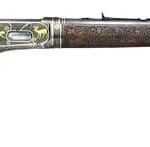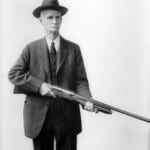
The Winchester Model 94
Few rifles have shaped American history like the Winchester Model 1894, known simply as the Winchester ’94. From deer camps in the North Woods to the saddle scabbards of cowboys and lawmen, this lever-action rifle became the trusted companion of hunters, ranchers, and explorers for more than a century. Designed by John Moses Browning and introduced in 1894 by the Winchester Repeating Arms Company, it was the first sporting rifle built for smokeless powder and went on to sell more than seven million units worldwide. The Winchester 94 wasn’t just a firearm, it was the bridge between the black-powder frontier and the modern age of American marksmanship.
This article delves into the historical, mechanical, and cultural legacy of the Model 94, tracing its lineage, production, use, and enduring influence on firearms design.
Development and Predecessors
The Winchester Model 1894 did not appear in isolation. It was the culmination of two decades of mechanical refinement, beginning with the legendary Winchester Model 1873—“The Gun that Won the West.” Manufactured by the Winchester Repeating Arms Company, the Model 1873 was a lever-action repeating rifle that relied on the older toggle-link action inherited from earlier Henry and 1866 rifles. While strong enough for black-powder cartridges such as the .44-40 Winchester, the toggle-link design could not safely handle the higher pressures of emerging high-powered rounds.
When larger cartridges like the .45-70 Government gained popularity, Winchester turned to a young Utah gunsmith named John Moses Browning. His response was the Model 1886—a masterpiece of mechanical strength featuring twin vertical locking blocks that transformed the lever-action rifle from a frontier repeater into a serious hunting weapon capable of managing powerful big-game loads.
Browning refined that concept with the Model 1892, a more compact and slick-cycling carbine scaled for revolver cartridges such as .38-40 and .44-40. But by the early 1890s, the firearms world was on the verge of another revolution: the rise of smokeless powder. These new propellants burned cleaner, produced far greater pressures, and required actions built to withstand higher mechanical stress. Recognizing the shift, Browning created a new action that was simpler, stronger, and specifically designed for smokeless cartridges. Introduced in 1894, it became the Winchester Model 1894, a rifle that would forever redefine the American sporting gun.
Manufacture and Production
The Winchester Model 94 was manufactured primarily by the Winchester Repeating Arms Company in New Haven, Connecticut. During the company’s long and varied corporate history, production was later overseen by Olin Corporation and subsequently the U.S. Repeating Arms Company (USRAC). More recently, Winchester-branded production was revived by Miroku in Japan, maintaining the same design principles that made the original famous.
When the Model 94 first rolled off the assembly line in October 1894, it represented a major leap forward in firearm engineering. The rifle was initially chambered for two black-powder cartridges, the .32-40 Winchester and the .38-55 Winchester, but it was the introduction of the .30 Winchester Center Fire (WCF) in 1895 that propelled the rifle to fame. The .30 WCF, later renamed the .30-30 Winchester, became the first American sporting cartridge specifically designed for smokeless powder. It offered unprecedented velocity and efficiency in a compact lever-action rifle, and the combination quickly dominated the deer woods of North America.
Over the years, Winchester expanded the Model 94’s chamberings to include the .25-35 WCF, .32 Winchester Special, .32-40, .38-55, and, in later years, modern options such as the .450 Marlin. Yet the .30-30 Winchester remains the cartridge most closely associated with the rifle, its reputation built on over a century of field success.
Serial number 1 was produced in 1894, and by 1927, Winchester celebrated the one-millionth Model 94. The two-millionth came in 1961, and by the time production first ceased in 2006, more than seven million rifles had been made—making it the most popular centerfire rifle in history.
Production ran almost continuously from 1894 to 2006, with only a few interruptions. The Second World War temporarily halted civilian rifle manufacturing between 1943 and 1948 as Winchester devoted its facilities to the war effort. Postwar production resumed with improved steels, new barrel alloys, and modernized sight options. In 1964, in response to rising production costs, Winchester introduced significant design changes including stamped and sintered parts. Collectors now refer to the earlier hand-fitted rifles as “pre-64” models which are highly prized for their craftsmanship, and the later rifles as “post-64” models, which were mechanically sound but less ornate.
In 1981, after financial difficulties, Olin licensed production to the U.S. Repeating Arms Company. Manufacturing continued in New Haven until 2006, when the plant closed its doors. Yet the rifle’s story didn’t end there. In 2010, production resumed under the Winchester name through Miroku of Japan, using modern CNC machining, superior steels, and contemporary safety features such as tang-mounted safeties and rebounding hammers. Even in its latest incarnation, the Model 94 remains unmistakably faithful to Browning’s original design.
Design and Operation
At the heart of the Winchester 94 lies an ingenious mechanism built around two vertical locking lugs that engage recesses in the bolt when the lever closes. This twin-lug system provides strength far beyond the older toggle-link pattern, allowing the rifle to handle the pressures of smokeless cartridges with complete safety. When the shooter cycles the lever, a cartridge is lifted from the tubular magazine by the carrier block, aligned with the chamber, and seated by the bolt in one fluid motion. The design’s efficiency allows a skilled marksman to fire six aimed shots in as many seconds.
Early receivers were machined from solid carbon steel forgings, polished and blued to a deep lustrous finish. After 1964, cost-saving measures brought investment-cast and sintered steel receivers, later returned to forged or machined steel in modern Miroku production. The standard barrel twist rate for .30-30 rifles is 1 turn in 12 inches, ideal for stabilizing 150- to 170-grain flat-nose bullets.
Safety features evolved over time. Early rifles relied on a simple half-cock hammer notch, later augmented with tang safeties and trigger blocks. Standard sights included buckhorn or semi-buckhorn rear sights and blade fronts, though later versions often used aperture or fiber-optic arrangements. Many models featured full-length tubular magazines, while some later carbines used half-tubes for balance.
The rifle’s ergonomics—its slender forearm, narrow receiver, and gentle crescent buttplate—make it exceptionally fast to mount and shoot. Weighing around six and a half pounds and available with barrels from 16 to 26 inches, it strikes a perfect balance between portability and stability.
Usage and Performance
The Winchester Model 94’s enduring popularity owes much to its versatility. It has seen use in nearly every corner of North America, in roles ranging from hunting and sport shooting to police service and even military deployment. The rifle’s light weight, short overall length, and rapid lever-action cycling make it ideal for dense-forest hunting and brush shooting, where shots are often within 150 to 200 yards.
The .30-30 Winchester cartridge, firing a 150- to 170-grain flat-nosed bullet at velocities between 2,200 and 2,390 feet per second, generates roughly 1,800 to 1,900 foot-pounds of muzzle energy. That level of power has long proven ideal for deer, black bear, feral hogs, and other medium-sized game. The round’s mild recoil and flat trajectory to 150 yards make it manageable for new shooters while still deadly effective in skilled hands.
Beyond hunting, the Model 94 saw limited law enforcement and military use. During World War I, the British Royal Flying Corps issued .30-30 Winchester Model 94 carbines as defensive arms for aircrews. In the 1950s, the French government purchased Model 94s for use by rural police and constabulary units. In America, railroad guards, prison wardens, and rural deputies carried them well into the 1970s. Its saddle-ring “Trapper” variants, fitted with 16-inch barrels, became popular among horse-mounted officers and ranch hands who valued the rifle’s fast handling and reliability.
Comparison with Contemporaneous Rifles
At the time of its introduction, few rifles could match the Model 94’s blend of power, speed, and reliability. Several contemporaries, however, competed for similar markets.
| Rifle | Year | Action Type | Cartridge Type | Notable Feature | Competitive Edge |
|---|---|---|---|---|---|
| Winchester Model 1894 | 1894 | Lever | Smokeless (.30-30 WCF) | Dual locking lugs, light weight | Balanced power and speed |
| Marlin Model 1893 | 1893 | Lever | Smokeless (.30-30 WCF) | Side ejection, solid top | Easier for scope mounting |
| Savage Model 1899 | 1899 | Lever | Smokeless (.303 Savage) | Rotary magazine, hammerless | Handles pointed bullets |
| Krag–Jørgensen | 1892 | Bolt | .30-40 Krag | Bolt-action military rifle | Longer range accuracy |
The Marlin Model 1893, introduced just a year earlier, was a formidable rival with its solid-top receiver and side-ejection system that facilitated scope mounting. However, for most of the 20th century, optical sights were rare on hunting rifles, and the Winchester 94’s top-eject design proved mechanically simpler and more weather-resistant. The Savage 1899, meanwhile, featured a rotary magazine that allowed the use of pointed bullets and a hammerless action, yet its complexity made it costlier. The Winchester 94, with its balance of affordability, strength, and ease of maintenance, won the hearts of hunters and frontiersmen alike.
Cultural Legacy and Collector Appeal
Beyond its technical achievements, the Winchester 94 became an American icon. It appeared in countless Western films, from John Wayne’s Stagecoach to the television series The Rifleman, embedding its silhouette in the collective imagination of the frontier. Generations of hunters grew up seeing it in hardware-store racks and Sears catalogs, and countless families passed their Model 94s from father to son as treasured heirlooms.
Collectors today draw an important line with the Model 94 between “pre-64” and “post-64” rifles. The earlier models, built with milled steel parts and hand-fitted walnut stocks, command significant premiums, often ranging from $1,200 to $2,500 depending on condition, configuration, and rarity. Factory carbines with original saddle rings, special-order rifles with half-magazines, and engraved presentation pieces fetch far higher sums. Later commemoratives such as the Canadian Centennial (1967), Buffalo Bill Commemorative (1968), and Antique Carbine (1977) are also sought-after, both for their decorative engraving and limited production numbers. Modern Miroku-made examples, though foreign-built, are recognized for their precision machining and polished finish, continuing the Winchester tradition with 21st-century craftsmanship.
Cultural Symbolism and Enduring Appeal
The Model 94’s cultural influence cannot be overstated. It symbolized independence, self-reliance, and a uniquely American balance between art and utility. Its appearance in films and literature transformed it from a working rifle into a mythic object—a bridge between the Wild West and modern hunting culture. Even as semi-automatics and bolt-actions came to dominate the market, the Winchester 94 retained its place in deer camps and gun safes, valued as much for sentiment as for function.
In the hunting world, the .30-30 Winchester cartridge remains synonymous with reliability and ethical power. Countless whitetail deer have fallen to its flat-nosed bullets, and entire generations of sportsmen cut their teeth with the “thirty-thirty lever gun.” Modern ammunition, with polymer-tipped spitzer bullets like Hornady’s LEVERevolution, has extended its effective range to 250 yards—proof that even in the age of polymer stocks and high-speed magnums, the old lever-action still has lessons to teach.
Historical Significance
The Winchester Model 94 was not only a success for its manufacturer but also a cornerstone of American firearms history. It embodied the transition from black-powder frontier weapons to the smokeless era. It also marked the maturation of John Browning as a designer whose innovations would dominate firearms development for the next half-century, influencing designs from pump shotguns to automatic pistols. The Model 94’s longevity—more than a century of continuous or revived production—speaks to a design so inherently balanced that it required little alteration.
It was the first sporting rifle to reach a million units sold, and to this day, it holds the record as the most-produced centerfire sporting rifle in history. Its mechanical efficiency and cultural symbolism combined to make it more than just a tool; it became an emblem of the American outdoorsman’s ethos.
FAQ
When was the Winchester Model 94 first made?
Production began in 1894 in New Haven, Connecticut, with initial chamberings in .32-40 and .38-55 Winchester.
What is the difference between pre-64 and post-64 Winchester 94s?
Pre-64 rifles used forged steel receivers and hand-fitted parts, while post-64 rifles incorporated stamped and cast components to reduce costs. The earlier guns are typically more collectible and often better finished.
Is the Winchester 94 still in production?
Yes. Current production is handled by Miroku of Japan under the Winchester brand, maintaining the same action and styling that defined the original.
What calibers has the Model 94 been chambered in?
Most famously in .30-30 Winchester, but also .25-35 WCF, .32 Winchester Special, .32-40, .38-55, and several commemorative or limited modern chamberings. Modern Model 94s can be found in
Conclusion
After more than a century, the Winchester Model 94 remains the best-selling sporting rifle ever built and one of the most influential firearms in history. Its design bridges three technological eras, black powder, smokeless powder, and modern CNC manufacturing without losing its soul. From the deer woods of Maine to the plains of Texas, from the saddle scabbards of cowboys to the hands of collectors, it endures as the quintessential American lever gun. To hold one today is to grasp a piece of history forged by John Browning’s genius and Winchester’s relentless pursuit of perfection.
The Winchester Model 94 is more than a rifle—it is the embodiment of American ingenuity, craftsmanship, and the enduring spirit of adventure.
Discussion groups on the Model 94 can be found here:
If you know of any forums or sites that should be referenced on this listing, please let us know here.



